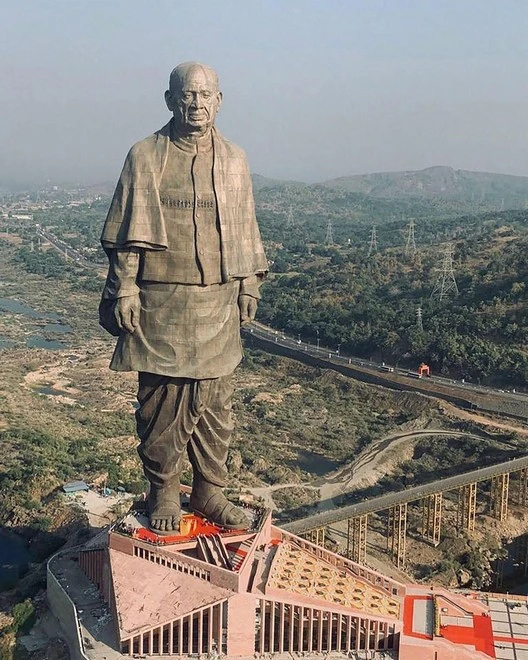Generated by Contentify AI

Introduction
Standing tall at 182 meters, the Statue of Unity in India is not merely a colossal structure; it embodies profound symbolism that goes beyond its physical stature. Designed to honor Sardar Vallabhbhai Patel, an iconic figure in Indian history known for his role in the country’s unification, the statue represents unity, strength, and resilience. Its location overlooking the Narmada River, surrounded by the natural beauty of the Sardar Sarovar Dam and the Satpura and Vindhya mountain ranges, further enhances its significance. The statue’s outstretched arms convey a message of welcome and inclusion, emphasizing the importance of unity in diversity. Through its symbolic representation, the Statue of Unity stands as a powerful reminder of the values that bind a nation together, serving as a source of inspiration for generations to come.
The History Behind the Statue
The Statue of Unity stands as a testament to the unity and strength of the Indian nation, symbolizing the spirit of solidarity and resilience that Sardar Vallabhbhai Patel advocated throughout his life. Its construction on Sadhu Bet Island holds historical significance, as it overlooks the Sardar Sarovar Dam, a symbol of progress and development. The statue’s design, with Patel’s outstretched arms, conveys a message of inclusivity and welcome, embodying the values that bind a diverse nation together. Positioned amidst the serene beauty of nature, surrounded by the Narmada River and majestic mountain ranges, the Statue of Unity serves as a powerful symbol of inspiration and national pride, reminding all who behold it of the importance of unity in the face of challenges.
Design and Architecture
The design and architecture of the Statue of Unity are not merely aesthetic features but integral components of its symbolic representation. The statue’s towering height of 182 meters reflects the monumental legacy of Sardar Vallabhbhai Patel, emphasizing his crucial role in unifying the diverse regions of India into one cohesive nation. The outstretched arms of the statue symbolize welcome and inclusivity, embodying the spirit of unity amidst diversity. Positioned strategically on Sadhu Bet Island, overlooking the Narmada River and surrounded by the natural beauty of the Sardar Sarovar Dam and mountain ranges, the statue’s architectural design integrates seamlessly with its symbolic significance, creating a powerful visual representation of strength, resilience, and national pride.
Symbolism in the Details
The intricate details of the Statue of Unity play a crucial role in conveying its profound symbolism. From the choice of materials to the positioning of the statue, every aspect has been carefully considered to reflect the values it represents. The use of bronze, a durable and resilient material, not only highlights the strength and unity embodied by Sardar Vallabhbhai Patel but also symbolizes the enduring spirit of the nation. The statue’s location overlooking the Narmada River and surrounded by nature underscores the interconnectedness between humanity and the environment, emphasizing the importance of harmony and balance. By incorporating these symbolic elements into its design, the Statue of Unity stands as a powerful reminder of the values that bind a nation together and inspire unity for generations to come.
Visitors’ Experience and Reactions
The visitors’ experience at the Statue of Unity is nothing short of awe-inspiring. As they stand before the colossal figure of Sardar Vallabhbhai Patel, the symbolism embedded in every detail of the statue becomes palpable. The outstretched arms of the statue seem to extend a warm embrace, welcoming all who approach with a message of unity and inclusivity. The location of the statue, overlooking the serene Narmada River and framed by the majestic mountain ranges, adds to the sense of grandeur and significance. Visitors often find themselves reflecting on the values of strength, resilience, and diversity that the statue represents, making their experience not just a sightseeing excursion, but a profound encounter with the essence of unity that lies at the heart of the nation.
The Impact on Local Communities
The presence of the Statue of Unity extends beyond its physical form, resonating deeply with local communities in the surrounding areas. The statue’s symbolism as a beacon of unity and strength serves as a source of inspiration for residents, fostering a sense of pride and connection to their shared heritage. Local businesses and artisans have also benefitted from the influx of tourists drawn to the monument, creating economic opportunities and sustainable growth for the region. Additionally, the statue’s focus on inclusivity and diversity sends a powerful message to the communities, promoting harmony and solidarity among people from all walks of life. Through its symbolic representation, the Statue of Unity not only stands as a tribute to a historical figure but also as a unifying force that uplifts and empowers the local populace.
Conclusion
The Statue of Unity, with its towering height and intricate design, encapsulates a rich tapestry of symbolism that resonates with visitors and locals alike. From the choice of materials to the positioning overlooking the Narmada River, every detail has been meticulously crafted to convey a message of unity, inclusivity, and strength. The outstretched arms of the statue symbolize a welcoming embrace, emphasizing the importance of coming together as a nation. Positioned amidst the natural beauty of the surrounding landscape, the statue serves as a powerful reminder of the values that bind a diverse nation together, inspiring all who encounter it. Through its thoughtful design and strategic placement, the Statue of Unity transcends its physical presence to embody a profound symbolic representation that speaks to the essence of unity and resilience.



